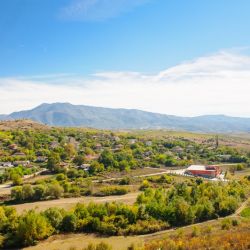RUPEL plants its vines with an area of 260 decares. Already in 2006-2008, in the lands of Dolno Spanchevo and Harsovo. The vineyards are created by varieties recommended for the region, in a wine-growing area with some of the best soils and climate, reminiscent of a small Tuscany. When choosing the varieties, importance is given to the appropriate terroir for the red varieties: merlot, cabernet sauvignon, marselan, melnik 55, sangiovese, nebbiolo. In 2017, the varieties Pinot Noir, Rubin, Vermentino, Viognier and Sandanski Misket are also planted. The supporting structure of the vineyard is made up of wooden poles and galvanized metal poles in the row. They have factory-made pins of 10 cm, which allows the double grids to be placed at optimal height depending on the stage of development of the vine shoots and the optimization of the manual operations. The well-constructed support structure is at the same time a prerequisite for trouble-free operation of tractors and mechanized activities carried out during vegetation: spraying, dusting, contour pruning and machining in the order of diverting sections.
The inter-row and inter-row distances are consistent with the climatic features of the area and the growth potential of the different varieties. This gives a sufficient area for the individual vineyards, which favors the lighting and ventilation of the vineyard.
Formations:
Merlot, Melnik 55, Marselan and Cabernet Sauvignon are formed on a double-sided cordon with 6-8 sticks. This is an easy to maintain form, giving a good and even distribution of the fetters. The presence of old wood favors the good ripening and accumulation of sugars and dyes in grapes.
Sanjovese is a Royan cordon formation, or a one-sided cordon with 4 sticks. In this way, the lighting and ventilation of grapes and leaves is optimal, the vines have a good fertility over the years. In this form, Sangiovese, characterized by its vigorous growth, has a good balance between yield and grape quality.
Nebbiolo is formed on a single stranded Gyuo. There is one stick and a fruit stick with 8 to 12 buds. The fruit stick provides the fruit, and the sticks are needed for the next year. The formulation provides a higher yield as the most rodent buds are used in the middle of the stick.
Since the first year of fruiting, vines have been approached carefully, system analyzes and controls have been carried out. For years, observations have continued, as they are now, seeking repeatability from positive results and defining the nature of the vineyard. The aim is to achieve optimal yield per hectare, to specify the technologies for growing grapes, as well as to purify the varieties by removing impurities and planting new vines. Successful achievement of excellent balance between quantity and quality. Key factors in the cultivation of the vineyard are “natural and organic”, as no chemical products, dangerous products for health and for plants are used. Only copper and sulfur products are used, feeding of the vines is done only with organic fertilizers and small doses of organomineral ones. All agricultural operations have been reduced to a minimum, and CO2 emissions have been reduced compared to the standard. In doing so, maximum care is taken for the environment, everything is done to reduce the impact on it.
The grape harvest starts at full ripening at the end of August for the early varieties, until the beginning of October for the late varieties. Grapes are picked by hand, transported carefully to the cellar in the immediate vicinity. With care, it is not necessary to sort the harvested grapes in advance before vinification. As it says, “The wine is made in the vineyard!”







